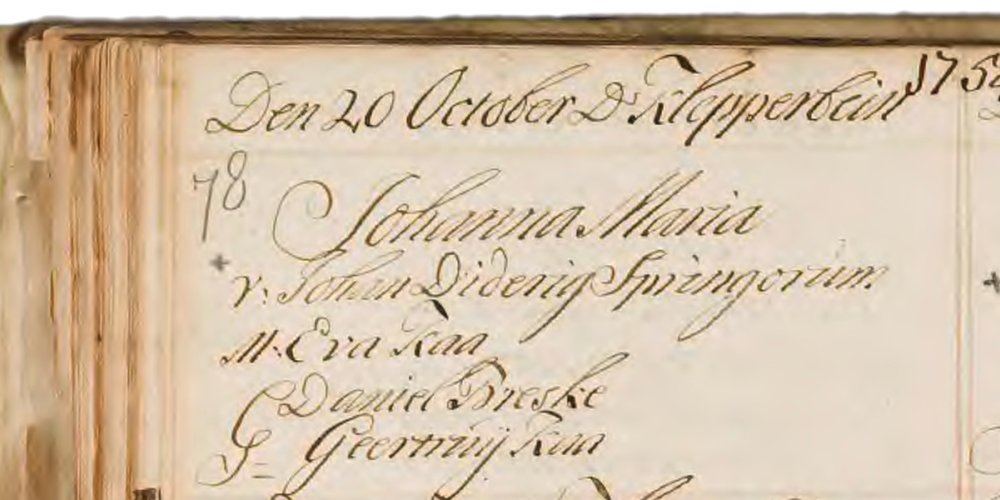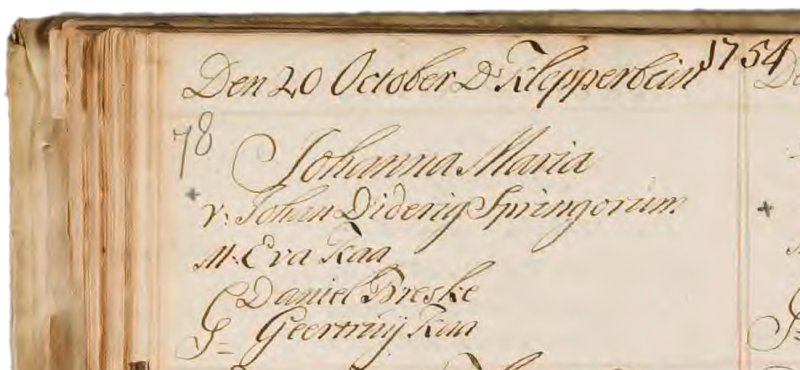Didrig Springorum (1732 - 1810)
the Merchant

Didrig Springorum
Didrig is not a direct ancestor of mine, but he does appear in the Amsterdam city archives—just before the names of Willem Springorum and Barend Springorum (both born in Henrichenburg) begin to show up. Didrig is ten years older than Barend, and the two are second cousins, sharing the same great-grandfather: Johannes Springorum, the pastor in Kirchende. It’s quite possible that Barend and Willem followed their cousin Didrig when they moved to Amsterdam.
Johann Dietherich (Joan Didrig) Springorum was born in Herdecke in 1732 as the son of Johann Bernhard Springorum and Gertrud Elisabeth Brenschede. He was probably named after his older brother Johann Dietrich who died at the age of three and a half in early 1732. At a young age, Didrig moved to Amsterdam as we see the first documents mentioning his name already in 1754.
Illegitimate child?
The earliest record I’ve found in Amsterdam mentioning Didrig Springorum is the baptism of his daughter, Johanna Maria Springorum, born to Didrig and Eva Kaa. At the time, Didrig was 22 years old and Eva was 29. Johanna Maria was baptized in the Lutheran Church but sadly passed away within six months of her birth. So far, I haven’t found any evidence that Didrig and Eva were ever married.

Image: Baptism record of Johanna Maria Springorum.

Image: Death record of Johanna Maria Springorum.
In 18th-century Amsterdam, illegitimate children were often baptized in the church, as baptism was seen as essential for the child’s soul, regardless of the circumstances of their birth. The baptismal record usually included the child’s name, the mother’s name, and sometimes a note indicating the child’s illegitimacy, such as natuurlijke zoon/dochter (natural son/daughter) or bastaard. The father's name, however, was rarely recorded unless he openly acknowledged paternity.
If the father did acknowledge the child, his name might appear in the register, but this was the exception rather than the rule. In cases where the father remained anonymous, the child’s surname often derived from the mother, or a generic placeholder like Jansen (son of Jan) or de Vries (common surname) was used.
Didrig the Merchant
After the loss of his daughter, Didrig is mentioned several times in Amsterdam notarial acts between 1755 and 1768. He is described as a merchant, including in a shipping declaration from 1755 stating that he personally transferred dyewood from a ship to his own sloop to deliver it to a customer. In a summons from 1761, he is urged to hurry with the delivery of three barrels of goods, to which he seems to respond immediately. His name also appears in bill protests and a receipt as the recipient of a wage.
1755, 11 juli – Ship's declaration
This notarial deed describes the precise circumstances that led to the shipping documents concerning a shipment of dyewood not being signed, or not being signed correctly.

In the month of May this year, there were laden aboard the aforementioned ship, in the port of Hamburg, together with other goods, ninety-three pieces of dyewood. This shipment was delivered by a man who, according to the first witness and corroborated by others, is named Frederik Cornelisse. The wood bore two distinct marks, to wit, FCF and CDF, as specified on three bills of lading. These documents indicated that the cargo was to be delivered to the order of the sender. The witnesses affirm that no other wood bearing these marks, destined for other parties, was loaded onto the ship.
On the 7th day of June, the ship arrived here in Amsterdam. Whilst the unloading of cargo was underway during that same month (and in the absence of the captain from the ship), one Mr. **J.D. Springorom** came aboard. He declared that he was to receive a portion of the wood marked CDF. A part thereof, he stated, was to be immediately unloaded and conveyed to the House of Correction (Tuchthuis), there to be cut and ground. Mr. Springorum himself entered the hold and selected seventeen pieces of the wood, which he carried away in the vessel that had brought him. He declared that all these pieces bore the mark CDF. The witnesses acknowledge that they did not carefully verify this but relied upon Mr. Springorum’s assertion, as the unloading of cargo was, at that moment, particularly bustling.
Subsequently, a boatman named Harmen Schriver came aboard to collect the remaining pieces of wood bearing the two aforementioned marks. This he did on behalf of Messrs. Springorum and Vasmer Bake, who together held the three bills of lading and the corresponding orders. The boatman removed, in two journeys, the remaining seventy-six pieces of wood, thereby completing the full tally of ninety-three pieces.
The witnesses declare that no bills of lading were signed upon delivery, as neither Mr. Springorum nor the boatman carried such documents at the time. Nonetheless, the delivery was made in good faith and to the best of their knowledge and conscience. The witnesses and the captain base their testimony on their experience and personal involvement with the ship and the events herein described, and they are prepared to affirm the truth of their declaration under oath. This declaration was made in Amsterdam, in the presence of Jan van Campen the Younger and Jan Schrijver as witnesses.
Dat in hun voonnoemde Schip tot Hamburg in de Maand May laastleden, onder meer den goederen ook syn geladen, door een man die den eersten getuyge en affirmant zeggen genaemt te zijn Hendrick Cornelisse, drie en negentig stucken verffhout, zynde van twee bijzondere merken als FCF en CDF, en waar van getekende Cognossementen alle houdende om uyt te leveren aan de ordres van de afzenders; hebbende, soo als ge raamentlijck verklaren, geen ander off vreemde conte van die merken van iemand ingeladen.
Dat sy van Hamburg met het voorns. Schip op den 7den Juny alhier voor dese stad gekomen zyn, zynde, onder het lossen van hun lading op sekeren dag in gemelde Maand Juny (soo als de getuygen particulier verklaren, also den affirmant toen niet aan boord was), by hun aan boord gekomen de Heer J. de Springorum, om die voorgaefde partye van dat hout gemerkt CDF te ontfangen, en van welke partye een deel aenstonts moest worden gelost om na het Tugthuys te senden ten eynde het selve gekapt en gemalen sou konnen werden.
De gemelde Heer is also selffs in ’t ruim gegaan en heeft van de voorn. partije hout zeventien stucken met sig genomen in de schuyt waar mee hy gekomen was, voorgevende alle deselve van het voorn. merk te zijn, ’t geen sy getuygen verklaren niet nagezien te hebben, maer sulcks aan den voornoemde Heer De Springorum te hebben toevertrouwt, om dat het heel drok op’t Schip met het lossen der koopmanschappen op die tyd toeging.
Verklarende in dese de getuygen en affirmant dat vervolgens een schuytevoerder is aan boord gekomen, die hy, eerste getuyge, verklaart genaemt te zijn Harmen Schriever, om de rest van al het hout van de voorsz. twee merken — waar van drie Cognossementen getekent waren — af te haelen, voor reekening van de voorsz. Heer De Springorum en de Heer Vasmer Bake tesamen, soo als den affirmant verklaart, welke beyde de drie Cognossementen en de ordres hadden van de voormelde afladers.
En aan welke schuytevoerder in twee reysen de resterende stucken hout, gemerkt als voren, ten getale van **zes en zeventig**, zijn uytgelevert, makende met de bevorens uytgeleverde **zeventien stucken** het geheele getal van **drie en negentig stucken hout**, sulcks daer aan niets mancqueerde. Dat van de voorsz. uyt leveringen geen Cognossementen zijn afgeteekent om dat de voormelde Heer **De Springorum** en ook den schuytevoerder, die door beyde de Heeren te gelyck geëmplyeert wierd, de selve niet by hun hadden. Sijnde egter de voorsz. uytleveringen ter goeder trouwe geschied.
Gevende sy getuygen en hy affirmant voor redenen van wetenschap, in de voorsz. qualiteyten op’t voornoemde Schip gevaren te hebben, en al het hier voor verklaerde, yder voor soo verre het hem aangaat, te hebben verricht, gezien, bijgewoond en ondervonden; en verder soo als in den Text staat vermeld, bereyd sijnde de deugdelijkheid dezer verklaring met solemnele Eede te sterken.
Aldus gepasseert binnen Amsterdam, ter presentie van Jan van Campen de Jonge en Jan Schrijver als getuygen.
Family life
In 1764, at the age of 39, Eva Kaa married 26-year-old Jan Hinderman. Her age is stated as 36 in the marriage certificate. The couple did not have any children.
Eight years later in 1772, at the age of 40, Didrig married 34-year-old Catharina Holtzheij, the widow of Nicolaas Albrecht, who had died a year earlier. No children were born from this marriage either, but together they took care of Maria Elizabeth Albrecht, Catharina's eight-year-old daughter from her first marriage.
Oproep notarissen https://www.delpher.nl/nl/kranten/view?query=spring%2Aor%2Aum&page=1&coll=ddd&sortfield=date&identifier=ddd:010720623:mpeg21:a0011&resultsidentifier=ddd:010720623:mpeg21:a0011&rowid=3